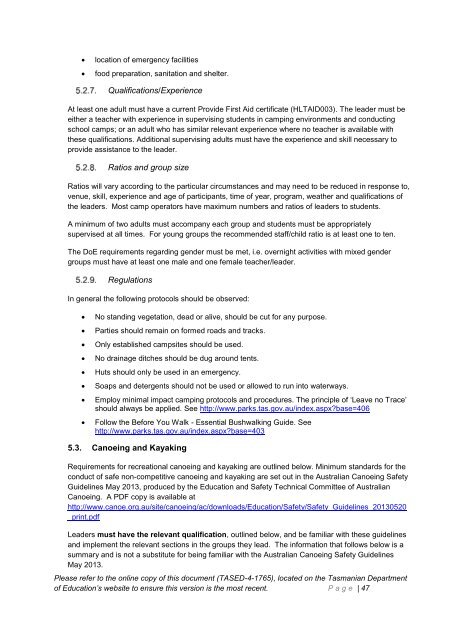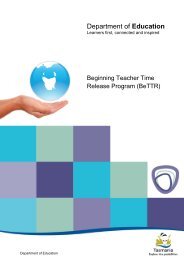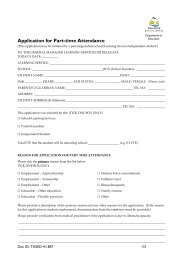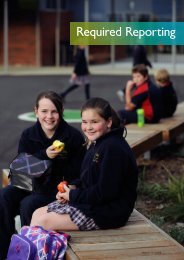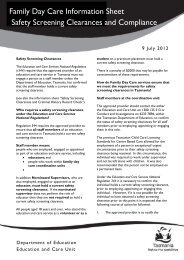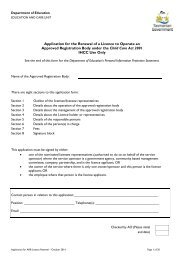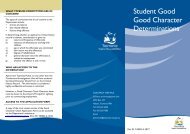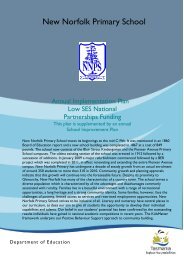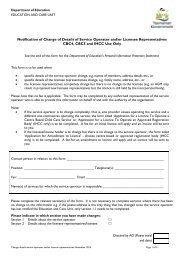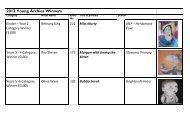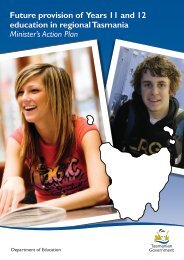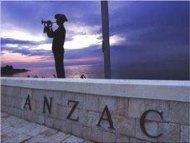PLANNING OFF CAMPUS ACTIVITIES
Procedures for Planning Off Campus Activities - Department of ...
Procedures for Planning Off Campus Activities - Department of ...
- No tags were found...
You also want an ePaper? Increase the reach of your titles
YUMPU automatically turns print PDFs into web optimized ePapers that Google loves.
location of emergency facilities<br />
food preparation, sanitation and shelter.<br />
Qualifications/Experience<br />
At least one adult must have a current Provide First Aid certificate (HLTAID003). The leader must be<br />
either a teacher with experience in supervising students in camping environments and conducting<br />
school camps; or an adult who has similar relevant experience where no teacher is available with<br />
these qualifications. Additional supervising adults must have the experience and skill necessary to<br />
provide assistance to the leader.<br />
Ratios and group size<br />
Ratios will vary according to the particular circumstances and may need to be reduced in response to,<br />
venue, skill, experience and age of participants, time of year, program, weather and qualifications of<br />
the leaders. Most camp operators have maximum numbers and ratios of leaders to students.<br />
A minimum of two adults must accompany each group and students must be appropriately<br />
supervised at all times. For young groups the recommended staff/child ratio is at least one to ten.<br />
The DoE requirements regarding gender must be met, i.e. overnight activities with mixed gender<br />
groups must have at least one male and one female teacher/leader.<br />
Regulations<br />
In general the following protocols should be observed:<br />
<br />
<br />
<br />
<br />
<br />
<br />
<br />
<br />
No standing vegetation, dead or alive, should be cut for any purpose.<br />
Parties should remain on formed roads and tracks.<br />
Only established campsites should be used.<br />
No drainage ditches should be dug around tents.<br />
Huts should only be used in an emergency.<br />
Soaps and detergents should not be used or allowed to run into waterways.<br />
Employ minimal impact camping protocols and procedures. The principle of ‘Leave no Trace’<br />
should always be applied. See http://www.parks.tas.gov.au/index.aspx?base=406<br />
Follow the Before You Walk - Essential Bushwalking Guide. See<br />
http://www.parks.tas.gov.au/index.aspx?base=403<br />
5.3. Canoeing and Kayaking<br />
Requirements for recreational canoeing and kayaking are outlined below. Minimum standards for the<br />
conduct of safe non-competitive canoeing and kayaking are set out in the Australian Canoeing Safety<br />
Guidelines May 2013, produced by the Education and Safety Technical Committee of Australian<br />
Canoeing. A PDF copy is available at<br />
http://www.canoe.org.au/site/canoeing/ac/downloads/Education/Safety/Safety_Guidelines_20130520<br />
_print.pdf<br />
Leaders must have the relevant qualification, outlined below, and be familiar with these guidelines<br />
and implement the relevant sections in the groups they lead. The information that follows below is a<br />
summary and is not a substitute for being familiar with the Australian Canoeing Safety Guidelines<br />
May 2013.<br />
Please refer to the online copy of this document (TASED-4-1765), located on the Tasmanian Department<br />
of Education’s website to ensure this version is the most recent. P a g e | 47


